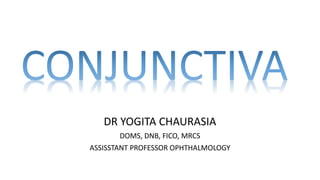This document discusses various types of conjunctivitis including bacterial, chlamydial, viral, allergic, and cicatricial conjunctivitis. It provides details on trachoma, a chronic keratoconjunctivitis caused by Chlamydia trachomatis. Trachoma has active and cicatricial stages, with signs including follicles, papillae, pannus, scarring, and corneal sequelae. Laboratory diagnosis involves conjunctival cytology, detection of inclusion bodies, ELISA for chlamydial antigens, PCR, and culture. Trachoma is a major cause of preventable blindness worldwide.






















































































